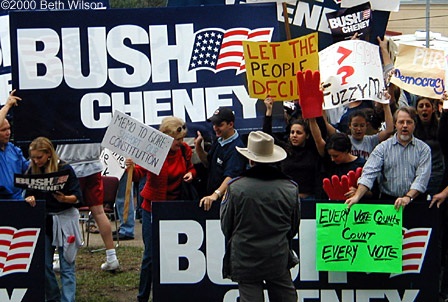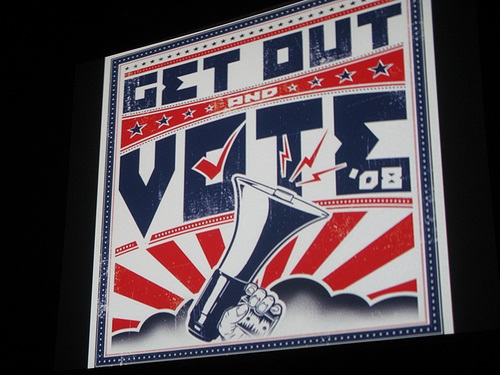

 After the 2000 presidential election, in which Al Gore won the majority of the popular vote, but not the election, there have been perennial discussions of the merit of using the Electoral College to elect the President. Fabrice Barthélémy, Mathieu Martin, and Ashley Piggins examine the so-called “referendum paradox” that resulted in the Bush victory and its effect on other presidential elections. They show that because of the Electoral College, the arbitrary size of the House of Representatives, not the voters, can determine the outcome of a presidential election.
After the 2000 presidential election, in which Al Gore won the majority of the popular vote, but not the election, there have been perennial discussions of the merit of using the Electoral College to elect the President. Fabrice Barthélémy, Mathieu Martin, and Ashley Piggins examine the so-called “referendum paradox” that resulted in the Bush victory and its effect on other presidential elections. They show that because of the Electoral College, the arbitrary size of the House of Representatives, not the voters, can determine the outcome of a presidential election.
Contrary to what many may think, the president of the United States is elected by an Electoral College, not the American public. On Election Day, the American public are in fact electing the members of this College (the “electors”), and shortly after Election Day, these 538 electors then choose the president. In the actual presidential election, each of these electors casts one “electoral vote”. At least 270 electoral votes are needed for victory, and a 269-269 tie is possible.
Where does that particular number, 538, come from? Each American voter votes in a particular state and each of these states is entitled to a number of electors equal to its total representation in Congress (House + Senate). For example, California currently has 55 electors and so 55 electoral votes. This corresponds to its 53 seats in the House of Representatives, plus 2 for its two Senators. If we add up across all 50 states in an identical fashion, this gives a total of 535 electors (corresponding to the 435 members of the House and 100 Senators). Three electors are added for the District of Columbia, which has no representation in Congress, giving a total of 538.
Of course, no voter votes for each elector by name. The political parties nominate a slate of electors prior to Election Day. A Californian voting for Obama/Biden is actually voting for 55 people they have never heard of, each of whom has been nominated by the Democratic Party in California. Almost all states operate a “winner-takes-all” rule under which the presidential candidate with the largest popular vote in the state (irrespective of the margin of victory) takes all of the state’s electors (and so, all of the state’s electoral votes). The two exceptions to this are Maine and Nebraska.

One of the most troubling features of the Electoral College system is that it is possible for a presidential candidate to get more popular votes than their rival, and yet still lose the election. This, of course, is precisely what happened to Al Gore in the 2000 presidential election. Despite obtaining half a million more votes than George W. Bush, Gore lost in the Electoral College by 271 to 267. This has happened twice before in American history, in 1876 and 1888. In fact, in 1876, the loser (Samuel Tilden, Democrat) even managed to obtain a strict majority of the national popular vote (51% compared to the winner’s (Rutherford Hayes, Republican) 48%).
The Finnish political scientist, Hannu Nurmi, calls this the “referendum paradox”. Whenever we have a referendum paradox, it is natural to feel that the “wrong” president was elected. Indeed, the enemies of the Electoral College would argue that the mere possibility of this paradox shows that the system needs replacing. Perhaps direct election of the President by the people would be better? Such a system would prevent these troubling outcomes from happening.
We consider some additional concerning features of the Electoral College. Recent research by Michael G. Neubauer and Joel Zeitlin, mathematicians at California State University in Northridge, reveals equally troubling properties of the Electoral College. Remember that number, 538 (= 435+100+3)? Neubauer and Zeitlin showed that if we increase the 435 component sufficiently (to at least 598), re-run the 2000 election again, getting everyone to vote in exactly the same way as they did on election day (and thus still giving the contested state of Florida to Bush), then Gore would actually have won in the Electoral College and been elected president! Strikingly then, the outcome of the 2000 election was determined by the size of the House of Representatives (which was fixed at 435 way back in 1911). If that number 435 happened to be any number between 50 (the lower bound specified by the Constitution) and 491, then Bush would have always won in 2000. At 598 and above, Gore always wins (with, somewhat surprisingly, a tie at 655). Between 491 and 598, sometimes Bush wins, sometimes Gore wins. The winner fluctuates in a seemingly random fashion.
The fact that the outcome of the 2000 election was determined by a decision taken in 1911 is surely troubling. As Neubauer and Zeitlin point out, in 1941, there was one representative per 301,000 citizens. Due to population growth, this ratio had fallen to one per 572,000 in 1990. Had the 1941 ratio been preserved then the size of the House in 1990 should have been about 830. Apportioning these 830 seats to the 50 states on foot of the 1990 census would have led to Gore taking 471 electoral votes to Bush’s 463 (in this hypothetical scenario, the District of Columbia would have received four electoral votes).
Extending Neubauer and Zeitlin’s work, we consider other elections with this strange characteristic. Some of them were subject to the referendum paradox. 1876 is one example. A larger House would have given Tilden victory. However, sometimes the referendum paradox can be, what we call, “entrenched”. In 1888, Grover Cleveland (Democrat) lost to Benjamin Harrison (Republican) by 168 electoral votes to 233. Cleveland obtained 48.63% of the popular vote, compared to 47.8% for Harrison. Surprisingly, increasing the House size in this case would not have benefitted Cleveland, the more popular candidate. The referendum paradox can hold irrespective of House size.
Two more interesting elections are 1976 and 1916. In 1976, Jimmy Carter (Democrat) beat Gerald Ford (Republican) by 297 electoral votes to 241. Carter also obtained more popular votes. There was no referendum paradox, in other words. However, a substantially smaller House would have caused Ford to win. The “inverse” of this occurred in 1916. In 1916, Woodrow Wilson (Democrat) defeated Charles Evan Hughes (Republican) and he also received more popular votes—again, no referendum paradox. However, in this case, a substantially larger House would have triggered the paradox, leading to Hughes’ victory.
What is troubling in all of these cases is that only the “architecture” of the Electoral College changes (in these examples, the size of the House), no one changes how they vote, and yet a different candidate is elected president. The architecture determines the outcome, not the voters.
What causes the “House size effect?” Nicholas R. Miller, a distinguished political scientist at the University of Maryland, explains the logical conditions that can give rise to a House size effect. To explain, let us go back to the 2000 election.

Although Gore won fewer states, the states he won (collectively) contained 51.68% of the U.S. population. The figure for Bush was only 48.32%. Imagine now that the size of the House keeps getting larger. As this happens, Bush’s Senate electoral votes remain fixed, but he obtains more House electoral votes. This will lower the importance of his Senate electoral votes as a proportion of his overall total. The same is true for Gore. This means that there will come a point where we can ignore Senate electoral votes entirely as they become increasingly dominated by House electoral votes. As the House size keeps increasing, the House electoral votes begin to dominate and Gore’s percentage of the electoral vote starts approaching 51.68%. As soon as this number flips over 50%, Gore wins the election without any American voter changing their vote.
Therefore, as Miller points out, an election is subject to a House size effect if (a) one candidate carries a majority of states, and (b) the other candidate carries states that (collectively) hold a majority of the U.S. population (more precisely, hold a majority of the total “apportionment population”). These logical conditions can explain what we observe in 2000, 1976, 1916, and 1876. Whenever an election is subject to a House size effect, a referendum paradox arises either for the actual House size or for some potential House size.
Changing the voting rule can change the outcome of an election, even when nobody changes how they vote. It is less well-known how subtle changes to parameters (what we call “architecture”) can affect outcomes in Electoral College-type elections. In these elections, the underlying voting rule in the states is held constant (the plurality rule is applied), but a feature of the Electoral College architecture is changed, which can alter the outcome of a presidential election.
This article is based on the paper “The architecture of the Electoral College, the House size effect, and the referendum paradox”, which recently appeared in Electoral Studies.
Please read our comments policy before commenting.
Note: This article gives the views of the author, and not the position of USApp– American Politics and Policy, nor of the London School of Economics.
Shortened URL for this post: http://bit.ly/1gTQILO
_________________________________________
 Fabrice Barthelemy- University of Versailles Saint-Quentin-En-Yvelines (France)
Fabrice Barthelemy- University of Versailles Saint-Quentin-En-Yvelines (France)
Fabrice Barthelemy is Professor of Economics at the University of Versailles Saint-Quentin-En-Yvelines (France). His research focuses on apportionment and power indices. He is also interested in real estate economics and finance.
 Mathieu Martin- University of Cergy-Pontoise (France)
Mathieu Martin- University of Cergy-Pontoise (France)
Mathieu Martin is Professor of Economics at the University of Cergy-Pontoise (France). His research interests are in social choice theory, power indices and game theory.
 Ashley Piggins- National University of Ireland Galway
Ashley Piggins- National University of Ireland Galway
Ashley Piggins is Senior Lecturer in Economics at the National University of Ireland Galway. His research interests are in social choice theory and issues on the boundary of economics and philosophy.



